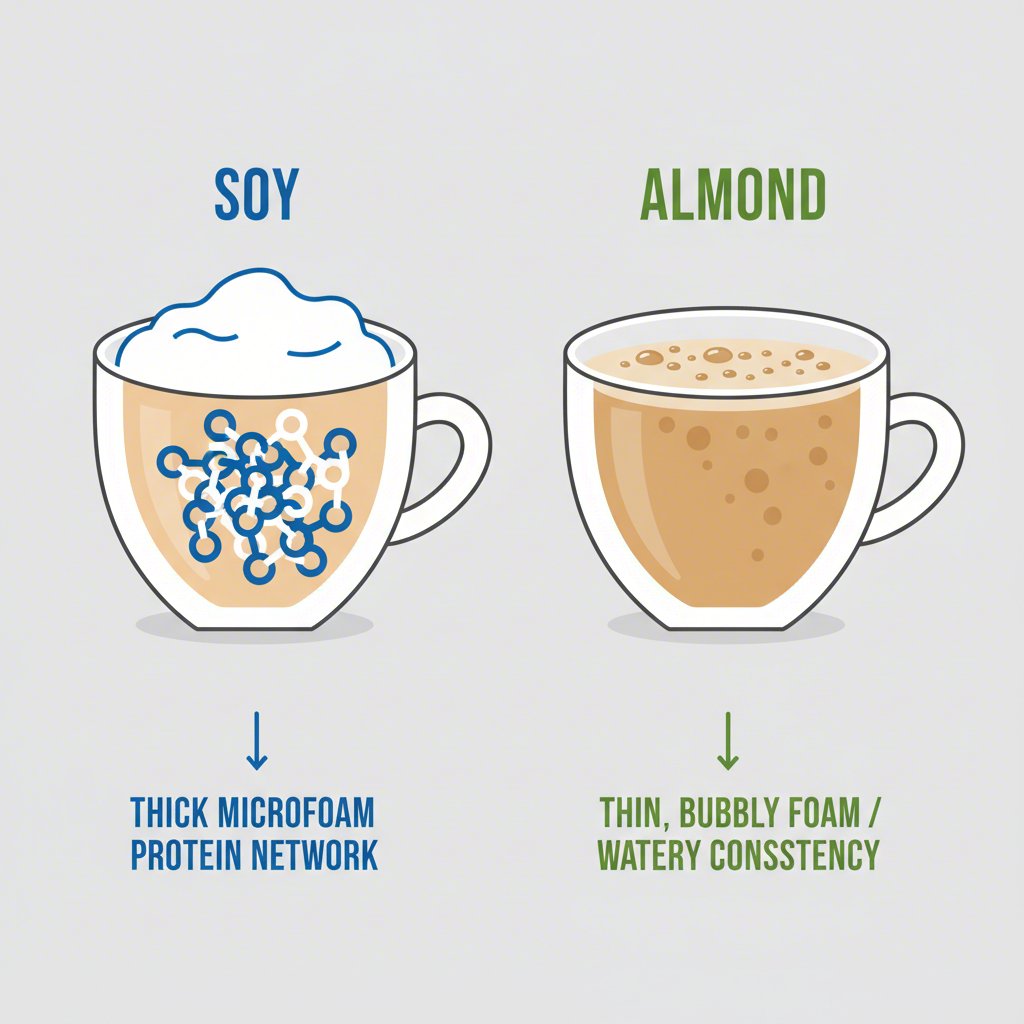TL;DR
When choosing between almond and soy milk for your coffee, the decision hinges on a trade-off between texture and taste. Soy milk is the clear winner for creaminess and frothing, thanks to its high protein content, making it ideal for lattes and cappuccinos. However, its distinct ‘beany’ flavor can sometimes overpower the coffee. In contrast, almond milk offers a lighter body, lower calories, and a more neutral flavor, but it’s thinner and provides less consistent foam.
The Ultimate Coffee Bar Showdown: Taste, Texture, and Frothing
The central conflict in the almond milk vs. soy milk debate comes down to performance in the cup. One offers rich, velvety texture while the other provides a lighter, more subtle touch. Understanding their fundamental differences is key to crafting your perfect coffee. Soy milk’s advantage lies in its composition; its higher protein content is the secret to a stable, dense microfoam that holds up beautifully in lattes and other espresso-based drinks. This is why it has long been a staple in coffee shops as a reliable dairy alternative.
On the other hand, almond milk has a much lower protein content, which makes it less dependable for frothing. While some barista blends are formulated to improve this, standard almond milk can produce a thin, bubbly foam that dissolves quickly. Furthermore, its stability can be an issue. As noted in tests by Seven Miles Coffee Roasters, the acidity (pH level) of coffee can cause some plant-based milks to curdle or separate, a problem more common with thinner milks like almond, especially when exposed to high heat. Soy milk tends to be more stable, though very acidic coffees can still cause it to separate over time.
Flavor is where personal preference takes center stage. Soy milk has an earthy, sometimes described as ‘beany,’ flavor that is quite noticeable. For some, this complements the coffee, but for others, it masks the delicate notes of the beans. Almond milk generally has a milder, nutty taste that interferes less with the coffee’s flavor profile. However, some find that unsweetened almond milk can impart a slightly bitter aftertaste, as a chemical reaction can occur with the coffee beans. For this reason, many prefer a sweetened variety for a smoother experience.
To simplify the choice, here’s a direct comparison of their performance attributes:
| Attribute | Soy Milk | Almond Milk |
|---|---|---|
| Taste Profile | Earthy and distinct; can be overpowering for some. | Mild, nutty, and more neutral; unsweetened versions can be slightly bitter. |
| Texture/Creaminess | Rich, creamy, and full-bodied, similar to dairy milk. | Thin, lighter, and more watery in consistency. |
| Frothing Ability | Excellent; creates dense, stable microfoam for latte art. | Poor to fair; produces light, airy bubbles that dissipate quickly. |
| Stability in Coffee | Generally stable, but can curdle in highly acidic coffee. | Prone to splitting or curdling, especially with high heat. |
Ultimately, the practical application is clear. For drinks where a rich, velvety foam is essential, such as cappuccinos and lattes, soy milk is the superior choice. For a simple splash in drip coffee or a cold brew where a neutral flavor and lower calorie count are desired, almond milk is often the preferred option.

A Nutritional and Health Deep Dive
Beyond the coffee cup, the nutritional profiles of almond and soy milk cater to very different dietary goals. The most significant distinction lies in their macronutrient content. Soy milk is a protein powerhouse in the plant-based world, offering a protein content comparable to dairy milk. In contrast, almond milk is exceptionally low in both protein and calories, making it a popular choice for weight management.
According to a nutritional comparison from Medical News Today, soy milk is the only dairy alternative that offers a similar amount of protein as cow’s milk. This makes it a more satiating option that can help you feel full longer. It also contains isoflavones, which are plant-based compounds that act as antioxidants and may help reduce inflammation. On the other hand, unsweetened almond milk’s primary health benefit is its low calorie count, which is often significantly lower than both soy and skim dairy milk.
Both milks are typically low in saturated fat and contain healthier monounsaturated and polyunsaturated fats. As noted by Mayo Clinic Press, unsweetened soy milk is the closest nutritional match to dairy milk among common plant-based alternatives. However, it’s important to be mindful of additives. Many commercial plant milks are fortified with calcium and vitamin D to mimic the levels found in cow’s milk, but they can also contain added sugars, oils, and thickeners like carrageenan, which some people prefer to avoid.
Here is a detailed nutritional breakdown per 100 grams, based on data from the U.S. Department of Agriculture:
| Nutrient | Soy Milk (Unsweetened) | Almond Milk (Unsweetened) |
|---|---|---|
| Calories | 38 | 15 |
| Protein | 3.55 g | 1.11 g |
| Total Fat | 1.88 g | 1.22 g |
| Carbohydrates | 1.29 g | 0.34 g |
| Sugars | 0.56 g | 0 g |
| Calcium | 101 mg | 173 mg |
Your health goals should guide your choice. If you are focused on maximizing protein intake or finding a nutritional equivalent to dairy, soy milk is the logical pick. For those prioritizing calorie reduction or seeking a lighter option for weight management, unsweetened almond milk is the clear winner.
The Final Verdict: Which Milk Is Right for Your Coffee?
After comparing performance and nutrition, it’s clear there is no single ‘best’ milk; the right choice is entirely subjective and depends on your priorities. Soy milk excels in creating a creamy, rich, cafe-style coffee experience, while almond milk is the go-to for a low-calorie, subtle addition to your daily brew. This aligns with rankings from sources like Greens Steel, which often place soy and almond in different tiers based on these distinct characteristics.
To make the decision easier, consider this simple matrix based on your primary goal:
| Your Priority | The Winner |
|---|---|
| Best for Lattes & Rich Foam | Soy Milk |
| Best for Low Calories | Unsweetened Almond Milk |
| Most Neutral Taste | Almond Milk |
| Highest Protein Content | Soy Milk |
It’s also important to acknowledge a major player not covered in this direct comparison: oat milk. In many taste tests and cafe settings, oat milk has emerged as the top choice, offering a superior balance of creaminess and neutral flavor that overcomes the main drawbacks of both almond and soy. As noted by both Seven Miles and Chowhound, its ability to froth beautifully without an overpowering taste makes it a formidable contender.
For those who want ultimate control over ingredients, freshness, and flavor, making plant-based milks at home is an excellent option. Looking to craft fresh, additive-free plant-based milks right in your kitchen? Soy Milk Quick offers an expert, comprehensive guide to the best plant milk makers for every need and budget. This allows you to avoid preservatives and customize sweetness to create the perfect milk for your coffee.
Based on your coffee habits, here are our final recommendations:
- For the Aspiring Home Barista: Soy milk is your best bet for practicing latte art and achieving that rich, cafe-quality texture.
- For the Calorie-Conscious Drinker: Unsweetened almond milk will add a touch of creaminess without the extra calories.
- For the Coffee Purist: A sweetened almond milk can provide smoothness without altering the delicate notes of your single-origin beans.
Frequently Asked Questions
1. Is soy or almond milk better in coffee?
Neither is definitively ‘better’—it depends on your preference. Soy milk is superior for creaminess and creating a stable, dense foam, making it ideal for lattes and cappuccinos. Almond milk is better if you prioritize low calories and a more neutral flavor that won’t interfere with the taste of your coffee. For frothy drinks, choose soy; for a simple, light addition, choose almond.
